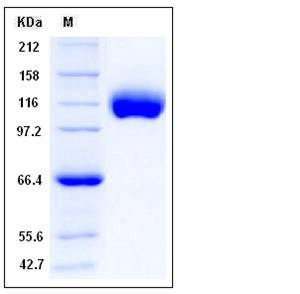Human CD21 / CR2 / C3DR Protein (His Tag)
C3DR,CD21,CR,CVID7,SLEB9
- 100ug (NPP3683) Please inquiry
| Catalog Number | P10811-H08H |
|---|---|
| Organism Species | Human |
| Host | Human Cells |
| Synonyms | C3DR,CD21,CR,CVID7,SLEB9 |
| Molecular Weight | The secreted recombinant human CD21 pro form consists of 962 amino acids with the predicted molecular mass of 106 kDa. As a result of glycosylation, the apparent molecular mass of rhCD21 is approximately 110-120 kDa in SDS-PAGE under reducing conditions. |
| predicted N | Ile 21 |
| SDS-PAGE |  |
| Purity | > 95 % as determined by SDS-PAGE |
| Protein Construction | A DNA sequence encoding the human CD21 isoform A (P20023-1) extracellular domain (Met 1-Arg 971) was expressed, with a carboxy-terminal polyhistidine tag. |
| Bio-activity | Measured by its binding ability in a functional ELISA . Immobilized human CD21 at 2 μg/ml (100 μl/well) can bind biotinylated human CD9. The EC50 of biotinylated human CD9 is 1.76 μg/ml. |
| Research Area | Immunology |Innate Immunity |Complement System |
| Formulation | Lyophilized from sterile PBS, pH 7.4 1. Normally 5 % - 8 % trehalose, mannitol and 0.01% Tween80 are added as protectants before lyophilization. Specific concentrations are included in the hardcopy of COA. |
| Background | The cluster of differentiation (CD) system is commonly used as cell markers in immunophynotyping. Different kinds of cells in the immune system can be identified through the surface CD molecules which associating with the immune function of the cell. There are more than 320 CD unique clusters and subclusters have been identified. Some of the CD molecules serve as receptors or ligands important to the cell through initiating a signal cascade which then alter the behavior of the cell. Some CD proteins do not take part in cell signal process but have other functions such as cell adhesion. CD21, also known as Complement component (3d / Epstein Barr virus) receptor 2 and CR2, is a member of the CD system and is a protein involved in complement system. CD21 is present on all mature B-cells and some T-cells and follicular dendritic cells. CD21 on mature B-cells form a complex called the B cell receptor complex with two other membrane proteins, CD19 and CD81. CD21 has a function in the complement system through serving as the cellular receper specific for ligands such as C3 and C4 which can be attached to foreign macromolecules in order to remove or uptake them. This results in B-cells having enhanced response to the antigen. |
| Reference |
